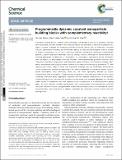Files in this item
Programmable dynamic covalent nanoparticle building blocks with complementary reactivity
Item metadata
| dc.contributor.author | Marro, Nicolas | |
| dc.contributor.author | della Sala, Flavio | |
| dc.contributor.author | Kay, Euan Robert | |
| dc.date.accessioned | 2019-11-22T15:30:07Z | |
| dc.date.available | 2019-11-22T15:30:07Z | |
| dc.date.issued | 2020-01-14 | |
| dc.identifier | 262531785 | |
| dc.identifier | 4f94d56b-4a94-4b1e-8794-916ae94e0c34 | |
| dc.identifier | 85077754209 | |
| dc.identifier | 000505529100005 | |
| dc.identifier.citation | Marro , N , della Sala , F & Kay , E R 2020 , ' Programmable dynamic covalent nanoparticle building blocks with complementary reactivity ' , Chemical Science , vol. 11 , no. 2 , pp. 372-383 . https://doi.org/10.1039/C9SC04195H | en |
| dc.identifier.issn | 2041-6520 | |
| dc.identifier.other | ORCID: /0000-0001-8177-6393/work/64697867 | |
| dc.identifier.uri | https://hdl.handle.net/10023/18986 | |
| dc.description | This work was supported by the EPSRC (EP/K016342/1, EP/P505097/1, EP/M506631/1) and the Leverhulme Trust (RPG-2015-042). ERK thanks the Royal Society of Edinburgh and Scottish Government for a Personal Research Fellowsh | en |
| dc.description.abstract | Nanoparticle-based devices, materials and technologies will demand a new era of synthetic chemistry where predictive principles familiar in the molecular regime are extended to nanoscale building blocks. Typical covalent strategies for modifying nanoparticle-bound species rely on kinetically controlled reactions optimised for efficiency but with limited capacity for selective and divergent access to a range of product constitutions. In this work, monolayer-stabilized nanoparticles displaying complementary dynamic covalent hydrazone exchange reactivity undergo distinct chemospecific transformations by selecting appropriate combinations of ‘nucleophilic’ or ‘electrophilic’ nanoparticle-bound monolayers with nucleophilic or electrophilic molecular modifiers. Thermodynamically governed reactions allow modulation of product compositions, spanning mixed-ligand monolayers to exhaustive exchange. High-density nanoparticle-stabilizing monolayers facilitate in situ reaction monitoring by quantitative 19F NMR spectroscopy. Kinetic analysis reveals that hydrazone exchange rates are moderately diminished by surface confinement, and that the magnitude of this effect is dependent on mechanistic details: surface-bound electrophiles react intrinsically faster, but are more significantly affected by surface immobilization than nucleophiles. Complementary nanoparticles react with each other to form robust covalently connected binary aggregates. Endowed with the adaptive characteristics of the dynamic covalent linking process, the nanoscale assemblies can be tuned from extended aggregates to colloidally stable clusters of equilibrium sizes that depend on the concentration of a monofunctional capping agent. Just two ‘dynamic covalent nanoparticles’ with complementary thermodynamically governed reactivities therefore institute a programmable toolkit offering flexible control over nanoparticle surface functionalization, and construction of adaptive assemblies that selectively combine several nanoscale building blocks. | |
| dc.format.extent | 12 | |
| dc.format.extent | 1394596 | |
| dc.language.iso | eng | |
| dc.relation.ispartof | Chemical Science | en |
| dc.subject | QD Chemistry | en |
| dc.subject | DAS | en |
| dc.subject | BDC | en |
| dc.subject | R2C | en |
| dc.subject.lcc | QD | en |
| dc.title | Programmable dynamic covalent nanoparticle building blocks with complementary reactivity | en |
| dc.type | Journal article | en |
| dc.contributor.sponsor | The Royal Society of Edinburgh | en |
| dc.contributor.sponsor | The Leverhulme Trust | en |
| dc.contributor.sponsor | EPSRC | en |
| dc.contributor.institution | University of St Andrews. School of Chemistry | en |
| dc.contributor.institution | University of St Andrews. EaSTCHEM | en |
| dc.identifier.doi | 10.1039/C9SC04195H | |
| dc.description.status | Peer reviewed | en |
| dc.identifier.grantnumber | n/a | en |
| dc.identifier.grantnumber | ORPG-3419 | en |
| dc.identifier.grantnumber | EP/K016342/1 | en |
This item appears in the following Collection(s)
Items in the St Andrews Research Repository are protected by copyright, with all rights reserved, unless otherwise indicated.

